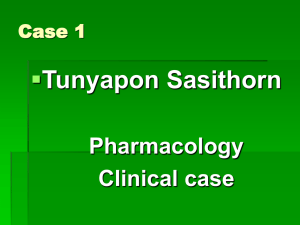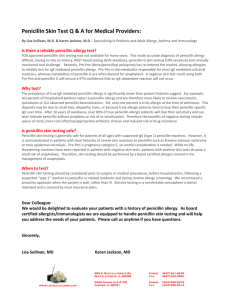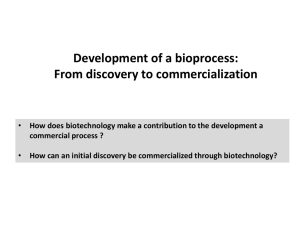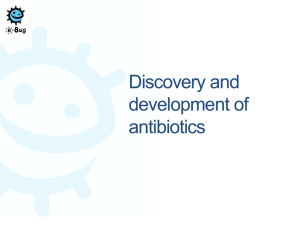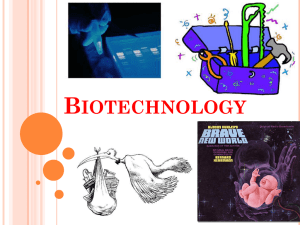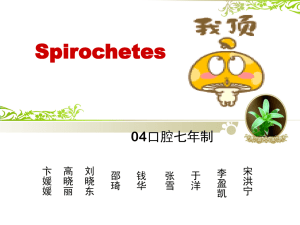Overview of Penicillin The onset of advancements in drug discovery
advertisement
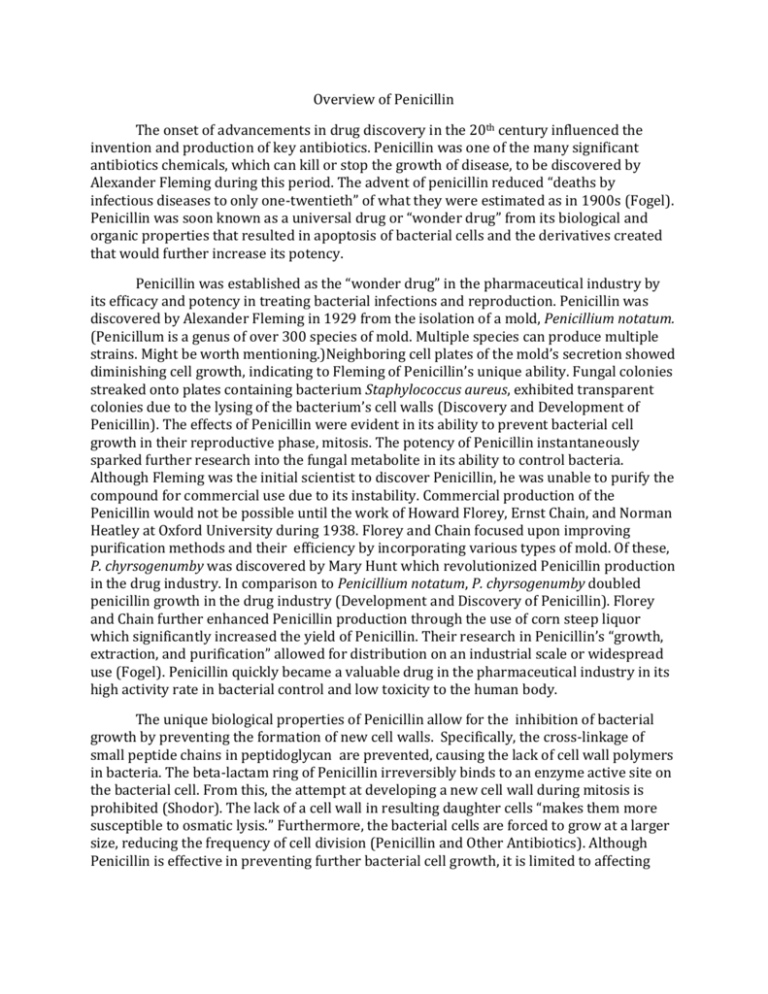
Overview of Penicillin The onset of advancements in drug discovery in the 20th century influenced the invention and production of key antibiotics. Penicillin was one of the many significant antibiotics chemicals, which can kill or stop the growth of disease, to be discovered by Alexander Fleming during this period. The advent of penicillin reduced “deaths by infectious diseases to only one-twentieth” of what they were estimated as in 1900s (Fogel). Penicillin was soon known as a universal drug or “wonder drug” from its biological and organic properties that resulted in apoptosis of bacterial cells and the derivatives created that would further increase its potency. Penicillin was established as the “wonder drug” in the pharmaceutical industry by its efficacy and potency in treating bacterial infections and reproduction. Penicillin was discovered by Alexander Fleming in 1929 from the isolation of a mold, Penicillium notatum. (Penicillum is a genus of over 300 species of mold. Multiple species can produce multiple strains. Might be worth mentioning.)Neighboring cell plates of the mold’s secretion showed diminishing cell growth, indicating to Fleming of Penicillin’s unique ability. Fungal colonies streaked onto plates containing bacterium Staphylococcus aureus, exhibited transparent colonies due to the lysing of the bacterium’s cell walls (Discovery and Development of Penicillin). The effects of Penicillin were evident in its ability to prevent bacterial cell growth in their reproductive phase, mitosis. The potency of Penicillin instantaneously sparked further research into the fungal metabolite in its ability to control bacteria. Although Fleming was the initial scientist to discover Penicillin, he was unable to purify the compound for commercial use due to its instability. Commercial production of the Penicillin would not be possible until the work of Howard Florey, Ernst Chain, and Norman Heatley at Oxford University during 1938. Florey and Chain focused upon improving purification methods and their efficiency by incorporating various types of mold. Of these, P. chyrsogenumby was discovered by Mary Hunt which revolutionized Penicillin production in the drug industry. In comparison to Penicillium notatum, P. chyrsogenumby doubled penicillin growth in the drug industry (Development and Discovery of Penicillin). Florey and Chain further enhanced Penicillin production through the use of corn steep liquor which significantly increased the yield of Penicillin. Their research in Penicillin’s “growth, extraction, and purification” allowed for distribution on an industrial scale or widespread use (Fogel). Penicillin quickly became a valuable drug in the pharmaceutical industry in its high activity rate in bacterial control and low toxicity to the human body. The unique biological properties of Penicillin allow for the inhibition of bacterial growth by preventing the formation of new cell walls. Specifically, the cross-linkage of small peptide chains in peptidoglycan are prevented, causing the lack of cell wall polymers in bacteria. The beta-lactam ring of Penicillin irreversibly binds to an enzyme active site on the bacterial cell. From this, the attempt at developing a new cell wall during mitosis is prohibited (Shodor). The lack of a cell wall in resulting daughter cells “makes them more susceptible to osmatic lysis.” Furthermore, the bacterial cells are forced to grow at a larger size, reducing the frequency of cell division (Penicillin and Other Antibiotics). Although Penicillin is effective in preventing further bacterial cell growth, it is limited to affecting only newly produced cells and not pre-existing bacterial cells. Clearly, the biological properties of Penicillin allow for it to become a universal drug in bacterial treatment. In addition to Penicillin’s distinctive biological properties were its organic properties. Its organic structure was deduced to be of a beta-lactam derived from valine and cysteine with a tripeptide intermediate replaced with an acyl group (Shodor). The organic structure exhibited a close relation to variations of Penicillin through the natural occurrence of Penicillin G and Penicillin V. Their differing chemical structures allow for varying properties in which Penicillin V is much more effective in acidic environments in comparison to Penicillin G. Both however, are only effective in the prevention of bacterial growth in Gram-positive bacteria, those with a cell wall that consists of thick layers of peptidoglycan. Ideally, Penicillin G and Penicillin V were used for treating pathogens that invaded the human body via wounds (Penicillin and Other Antibiotics). The restrictions of Penicillin G and Penicillin V called for the synthesis of new variations that could be effectively applied to certain environments thus leading to the development of semisynthetic penicillin. The natural versions were modified by “removing the acyl from 6aminopenicillanic acid,” allowing for the addition of various acyl groups with specific properties. From this, varying types of Penicillin were deduced such as Ampicillin, Carbenicillin, and Oxacillin. Each had their unique properties where they were “resistant to stomach acid, resistant to penicillinase, and possess extended range of activity against Gram-negative bacteria,” respectively. Evidently, the chemical structure of Penicillin allowed for it to rapidly become the universal drug due to itsversatility in the drug industry. Within recent years bacterial resistance to penicillin has become more common. Penicillin usually falls into two categories, Biosynthetic and semi-synthetic. Biosynthetic is natural penicillin that is harvested from mold through fermentation, while semi-synthetic penicillin are chemically modified derivatives allow the drug to have new properties. Penicillinase is the enzyme within bacteria that has evolved to destroy penicillin. Bacteria that contain the penicillinase compound have a resistance to penicillin. The most common name for this group of enzymes that are produced by bacteria is Beta-lactamase. Betalactamases provide resistance against anti-biotics due to their ability to break down the structure of the anti-biotic. This enzyme uses the mechanism of hydrolysis; the enzyme breaks the beta-lactam ring open which deactivates the molecular antibacterial property.. Due to this reason it is very important that penicillin is used with utmost care, due to the fact that there may be bacterial resistance to this drug. Due to this family of enzymes, betalactamases, new derivatives of penicillin were developed, such as cephamycins and carbapenems. Within this group of beta-lactam antibiotics, carbapenems have the highest resistance to most beta-lactamases. This is due to the carbapenem structure. From its structure, carbapenems have a similar 5 carbon ring feature as its parent compound, penicillin, with an additional unsaturated bond between C2 and C3 and a substitution of carbon at C1 for sulfur. The replacement of carbon 1 with sulfur helps contribute in the potency and spectrum of the compound against β- lactamases bacteria with higher stability. Furthermore, its stereochemistry of a trans configuration at C5 and a R chirality center at C8 increase its antimicrobial spectrum, which corresponds to higher resistance to hydrolysis by the β- lactamases. In term of origin, Carbapenem was developed from carbapenem thienamycin. Carbapenem thienamycin was first discovered in 1976 through streptomyces. Stretomyces are a family of bacteria belonging to the streptomycetaceae family. Thienamycin is the most potent naturally produced anti-biotic. This is an excellent drug against both gram positive and negative bacteria and is resistant to Beta-lactamases enzymes. Unlike penicillin, thienamycin is a naturally occurring antibiotic that has resistance to beta-lactamases. One important substituent of the two structures, carbapenem and thienamycin, that cause relatively high resistance to hydrolysis of most βlactamases is the hydroxyethyl side chain of thienamycin. The side chain has an acyl amino substituent on the β- lactam ring, which provides potent antibacterial and inhibitory activity. Although these two β- lactamases inhibitors provide the? greatest potency against the bacteria, more resistant bacteria, such as multidrug-resistant pathogens, are emerging. Due to the vast library of bacteria that has been discovered to have anti-biotic resistance, more and more drugs have to be discovered that are capable of destroying bacteria. Carpaenems, which have the broadest spectrum of activity against gram-positive and negative bacteria, are used to treat complicated bacterial infections in clinical uses. This penicillin β group is combined with an antibiotic, which targets gram- positive if use to treat severe hospital-acquired infection as empirical treatment. The antibiotics contain groups of compounds that vary in the types of treatment for patients, which include “antipseudomonal, anti-methicillin-resistant S. aureus (MRSA) carbapenems (i.e., cationic and dithiocarbamate carbapenems), orally available carbapenems, trinem carbapenems, and a dual quinolonyl-carbapenem (Antimicrob. Agents Chemother. November 2011 vol. 55 no. 11 4943-4960)”. Interestingly, the first oral carpaenems invented was Tebipenempivoxil, which increased the intestinal absorption for patients, particularly children with pneumonia illness. Although Carpaenems are beneficial, careful care prescribed from doctors should be considered to heal the necessary infections. With today’s modern technology and need for medication, anti-biotics are not developed on a micro but amacro scale. Industrial production of penicillin and also other beta-lactam antibiotics are very tedious tasks that require constant monitoring. Most of these antibiotics require fermentation.. The concepts to consider within industrial fermenters are functionality and economics. Within the economic aspect the fermenter has to be easy to “operate, flexible, low power consumption, stable, cheap”. The functional aspects of the fermenter have these following characteristics: a “high gas/liquid mass transfer, reasonable heat transfer aggregation prevention, bulk flow, and nutrient transfer”. Mass transfer is a very important aspect of the fermenter because it facilitates the flow of oxygen within the tank. Oxygen is very important because mold is an aerobic organism; therefore, it is important to have a good flow of oxygen between molds and liquid. Heat transfer is very important because metabolism is an exothermic process. Therefore, there have to be systems that cool the reactor. There also has to be a continuous culture that allows liquid to be added in and simultaneously released. Along with this there are special conditions for penicillin; most penicillin’s require a pH of 6.5 for growth, this is mostly maintained by the addition of sodium hydroxide (NaOH). These are the optimum conditions for facilitating the production of penicillin. The rapid growth of Penicillin in the early 20th century has been exhibited in its ability to treat bacterial infections and its versatility. Its discovery and growth as a drug enabled for the advancement in medicine and drug discovery in which previous ailments have an easily identifiable cure. Its efficacy influenced the development of new antibiotics while remaining as a front-line antibiotic. Ultimately, Penicillin can be regarded as the universal or wonder drug to a significant extent due to its versatility and potency in the medicinal environment.

